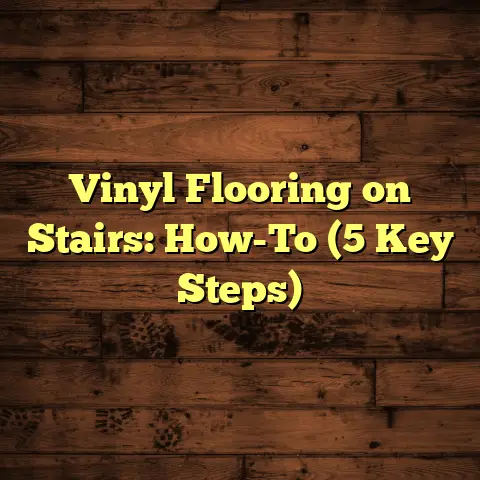Bolting A Safe To Wood Floors? (1 Mistake Kills!)
Let’s talk about something super important: keeping your valuables safe and sound.
I’m not just talking about insurance; I’m talking about that deep-down peace of mind that comes from knowing your precious belongings are protected.
Let me tell you a story.
A few years back, I got a call from a family who had experienced a break-in.
They weren’t just robbed; they were violated.
The thieves didn’t just take electronics; they took irreplaceable family heirlooms, important documents, and a sense of security that was shattered into a million pieces.
I remember the wife’s voice, trembling as she described the scene.
“It wasn’t just the stuff,” she said, “it was the feeling that someone had invaded our home, our safe space.”
That conversation stuck with me.
It reinforced the importance of taking proactive measures to safeguard our belongings.
And that’s where bolting a safe to your wood floors comes in.
It’s a crucial step, but one wrong move can render your safe practically useless.
Trust me, you don’t want to learn this the hard way.
So, stick with me, and I’ll guide you through the process, highlighting the one critical mistake that can turn your safe into a giant paperweight.
Section 1:
The Importance of Securing Your Valuables
Why is securing your valuables so darn important?
Well, it’s about more than just money.
It’s about protecting your history, your memories, and your peace of mind.
Think about it:
What would you do if you lost your grandmother’s wedding ring, your children’s birth certificates, or the title to your home?
The emotional and financial implications can be devastating.
According to the FBI, in 2022, there were an estimated 877,698 burglaries in the United States. FBI Crime Data Explorer
That’s a sobering statistic.
And while the average loss per burglary was around $3,000, the emotional cost is often far greater.
I’ve seen firsthand the impact of theft on families.
I remember one client, a retired teacher, who had her home ransacked.
The thieves took her jewelry, her savings, and something even more precious: her sense of security.
She told me she couldn’t sleep in her own bed for weeks, constantly reliving the experience.
Securing your valuables isn’t just about preventing financial loss; it’s about protecting your well-being and your family’s sense of safety.
It’s about creating a fortress of peace within your own four walls.
Section 2:
Understanding the Basics of Safes
Okay, so you’re ready to invest in a safe.
Great!
But before you run out and buy the first one you see, let’s talk about the different types of safes available.
It’s like choosing the right tool for the job; you need to understand your options.
-
Fireproof Safes: These are designed to protect your documents and valuables from fire damage.
They have a fire-resistant lining that can withstand high temperatures for a certain period of time.
Look for a safe with a UL (Underwriters Laboratories) rating, which indicates how long it can withstand specific temperature levels.
-
Burglary Safes: These are built to resist forced entry.
They typically have thicker steel walls, stronger locking mechanisms, and tamper-resistant features.
Again, look for a UL rating, specifically the TL (Tool Resistant) rating, which indicates how well the safe can withstand attacks from tools like drills and crowbars.
-
Combination Fire and Burglary Safes: These offer both fire and burglary protection, providing a comprehensive solution for safeguarding your valuables.
-
Wall Safes: These are designed to be concealed within a wall, offering an added layer of security.
They’re typically smaller than floor safes but can be a good option for storing jewelry, cash, or important documents.
-
Floor Safes: These are designed to be bolted to the floor, making them more difficult to move or steal.
They’re often larger and heavier than wall safes, providing more storage space and a higher level of security.
When choosing a safe, consider your specific needs:
-
What are you storing? (Documents, jewelry, firearms?)
-
What level of protection do you need? (Fire, burglary, or both?)
-
What’s your budget?
Don’t skimp on quality.
A cheap safe is often just a flimsy metal box that can be easily broken into.
Invest in a safe that’s built to last and provide the protection you need.
I often recommend talking to a reputable safe dealer who can assess your needs and recommend the right safe for your situation.
They can also provide valuable advice on installation and maintenance.
Section 3:
The Process of Bolting a Safe to Wood Floors
Alright, let’s get down to business.
You’ve chosen your safe, and now it’s time to bolt it to your wood floor.
This is where precision and care are key.
Follow these steps carefully to ensure your safe is securely anchored.
Step 1: Gather Your Tools and Materials
You’ll need:
- Your Safe: Obviously!
- Drill: A powerful drill with a hammer function is recommended.
-
Drill Bits: You’ll need drill bits specifically designed for drilling through steel and wood.
Refer to the safe’s manual to know the exact sizes. * Socket Wrench Set: To tighten the bolts. * Marking Pencil or Pen: To mark the bolt hole locations. * Measuring Tape: To ensure accurate placement. * Safety Glasses: Protect your eyes from flying debris. * Gloves: Protect your hands. * Heavy-Duty Anchor Bolts: These are crucial for securing the safe to the floor.
I recommend using concrete anchor bolts even for wood floors, as they provide superior holding power.
Make sure the bolts are long enough to go through the safe’s mounting holes, the wood flooring, and into the subfloor.
Step 2: Choose the Right Location
-
Accessibility: You want to be able to access your safe easily, but you also want to keep it out of sight.
-
Concealment: Consider placing the safe in a closet, under a bed, or behind a piece of furniture.
-
Floor Stability: Make sure the floor is level and stable.
Avoid placing the safe near walls or in areas with known structural issues.
Step 3: Mark the Bolt Hole Locations
-
Carefully position the safe in your chosen location.
-
Open the safe door (if possible) and locate the mounting holes inside the safe.
-
Using your marking pencil, mark the exact location of each hole on the floor.
-
Remove the safe and double-check your markings to ensure they’re accurate.
Step 4: Drill the Pilot Holes
-
Put on your safety glasses and gloves.
-
Using the appropriate drill bit, drill pilot holes through the wood flooring and into the subfloor at each marked location.
-
Make sure the holes are deep enough to accommodate the anchor bolts.
Step 5: Install the Anchor Bolts
-
Insert the anchor bolts through the mounting holes in the safe and into the pilot holes in the floor.
-
Using your socket wrench, tighten the bolts until they’re snug.
Don’t overtighten them, as this could damage the safe or the flooring.
Step 6: Test the Installation
-
Once the bolts are tightened, try to move the safe.
It should be securely anchored to the floor and should not budge.
-
If the safe moves, double-check the bolts to ensure they’re properly tightened.
If necessary, you may need to use longer or stronger bolts.
Safety Precautions:
-
Always wear safety glasses and gloves when drilling.
-
Use the correct drill bits for the materials you’re drilling through.
-
Be careful not to damage the flooring when drilling.
-
Don’t overtighten the bolts.
-
If you’re not comfortable with any of these steps, hire a professional.
Section 4:
Common Mistakes to Avoid When Bolting a Safe
Okay, we’ve covered the process, but now let’s talk about the elephant in the room:
The one critical mistake that can completely undermine your efforts.
Improper Anchoring.
That’s it.
That’s the mistake that kills.
What does improper anchoring entail?
It means not securing the safe correctly to the floor.
It could be using the wrong type of bolts, not drilling deep enough, or failing to account for floor stability.
The consequences can be disastrous.
Imagine this:
You’ve gone through all the trouble of buying a safe and bolting it to the floor.
You feel confident that your valuables are protected.
But then, a burglar comes along and, with a little effort, simply lifts the safe off the floor because it wasn’t properly anchored.
All that time, money, and effort wasted.
I’ve seen it happen.
I remember one client who thought he had done everything right.
He bought a decent safe and bolted it to his wood floor using what he thought were heavy-duty bolts.
But he didn’t drill deep enough, and he used bolts that were too short.
The result?
The burglar simply pried the safe off the floor and made off with his valuables.
Other common pitfalls include:
-
Inadequate Weight Distribution: If the safe is too heavy for the floor, it can cause the floor to sag or even collapse.
Make sure the floor can support the weight of the safe, especially if you’re installing it on an upper floor.
-
Using the Wrong Type of Bolts: Not all bolts are created equal.
Use heavy-duty anchor bolts specifically designed for securing objects to concrete or wood.
Avoid using drywall screws or other light-duty fasteners.
-
Failing to Account for Floor Stability: If the floor is uneven or unstable, it can compromise the security of the safe.
Make sure the floor is level and stable before installing the safe.
If necessary, reinforce the floor with additional supports.
This section is a cautionary tale.
Don’t take shortcuts.
Don’t cut corners.
Get it right the first time.
Your peace of mind depends on it.
Section 5:
Real-Life Case Studies
Let’s dive into some real-life scenarios to illustrate the importance of proper safe installation.
Case Study 1: The Successful Installation
Meet John, a homeowner who took the time to research and properly install his safe.
He chose a high-quality burglary safe with a UL TL-15 rating.
He carefully followed the steps I outlined earlier, using heavy-duty anchor bolts and ensuring the safe was securely anchored to the concrete subfloor.
A few years later, John’s home was targeted by burglars.
They tried to pry open the safe, but they were unsuccessful.
The safe remained securely anchored to the floor, and the burglars eventually gave up and fled.
John’s valuables were protected, and he was able to avoid a potentially devastating loss.
Case Study 2: The Costly Mistake
Then there’s Sarah, who tried to save money by installing her safe herself without doing proper research.
She bought a cheap safe and used light-duty bolts to secure it to her wood floor.
She didn’t account for the weight of the safe, and the floor began to sag.
One day, Sarah returned home to find her safe missing.
The burglars had simply lifted it off the floor and carried it away.
Sarah lost thousands of dollars worth of jewelry, cash, and important documents.
She learned a valuable lesson about the importance of proper safe installation.
Testimonials:
-
“I was so glad I took the time to properly bolt my safe to the floor. It gave me peace of mind knowing my valuables were secure.” – Mark, Homeowner
-
“I made the mistake of using cheap bolts when I installed my safe. I learned my lesson the hard way when my safe was stolen.”
- Lisa, Homeowner
These case studies and testimonials highlight the importance of doing your homework and taking the necessary steps to properly secure your safe.
Don’t become a statistic.
Learn from the mistakes of others and invest in your peace of mind.
Conclusion
We’ve covered a lot of ground, haven’t we?
From the emotional impact of theft to the nuts and bolts of safe installation.
I hope you’ve gained a deeper understanding of the importance of securing your valuables and the critical role that bolting a safe to your wood floors plays in that process.
Remember that story I shared at the beginning?
The family who lost their sense of security after a break-in?
You don’t have to be a victim.
You can take control of your safety and security by taking the necessary steps to protect your belongings.
Don’t let improper anchoring be your undoing.
Take the time to do it right, and you’ll sleep soundly knowing your valuables are safe and sound.
Your peace of mind is worth it.





